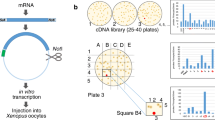Abstract
Secretion of organic anions by the kidney plays a critical role in the elimination of toxic agents from the body. Recent findings in isolated membranes and intact tissue have demonstrated the participation of multiple transport proteins in this process. As a first step toward molecular characterization of these proteins through expression cloning, the studies reported below demonstrate functional expression of both fumarate- and lithium-sensitive glutarate and probenecid-sensitive p-aminohippurate transport in Xenopus oocytes injected with rat kidney poly(A)+RNA. Maximal increase in substrate uptake over buffer-injected controls was reached by 5 days after mRNA injection. Expression of size-fractionated mRNA indicated that the active species with respect to both transport activities were in the range of 1.8 to 3.5 kb.
Similar content being viewed by others
References
Pritchard JB, Miller DS: Proximal tubular transport of organic anions and cations. In: DW Seldin and G. Giebisch (eds) The Kidney: Physiology and Pathophysiology, 2nd ed. Raven Press, New York, 1992, pp 2921–2945
Fritzsch G, Rumrich G, Ullrich KJ: Anion transport through the contraluminal cell membrane of renal proximal tubule. The influence of hydrophobicity and molecular charge distribution on the inhibitory activity of organic anions. Biochim Biophys Acta 978: 249–256, 1989
Pritchard JB: Luminal and peritubular steps in renal transport of p-aminohippurate. Biochim Biophys Acta 906: 295–308, 1987
Pritchard JB: Coupled transport of p-aminohippurate by rat basolateral membrane vesicles. Am J Physiol 255: F597-F604, 1988
Shimada H, Moewes B, Burckhardt G: Indirect coupling to Na of p-aminohippuric acid uptake into rat renal basolateral membrane vesicles. Am J Physiol 253: F795-F801, 1987
Martinez F, Manganel M, Montrose-Rafizadeh C, Werner D, Roch-Ramel F: Transport of urate and p-aminohippurate in rabbit renal brush-border membranes. Am J Physiol 258: F1145-F1153, 1990
Kahn AM, Aronson PS: Urate transport via anion exchange in dog renal microvillus membrane vesicles. Am J Physiol 244: F56-F63, 1983
Aronson PS: The renal proximal tubule: A model for diversity of anion exchangers and stilbene-sensitive anion transporters. Annu Rev Physiol 5: 419–441, 1989
Holohan PD, Pessah NI, Pessah IN, Ross CR: Reconstitution of N1-methylnicotinamide and p-aminohippuric acid transport in phospholipid vesicles with a protein fraction isolated from dog kidney membranes. Mol Pharmacol 16: 343–356, 1979
Goldinger JM, Khalsa BDS, Hong SK: Photoaffinity labeling of organic anion transport system in proximal tubule. Am J Physiol 247: C217-C227, 1984
Hediger MA, Coady MJ, Ikeda TS, Wright EM: Expression cloning and cDNA sequencing of the Na+/glucose co-transporter. Nature (London) 330: 379–381, 1987
Hediger MA, Turk E, Wright EM: Homology of the human intestinal Na+/glucose and Escherichia coli Na+/proline cotransporters. Proc Natl Acad Sci USA 86: 5748–5752, 1989
Frech GC, VanDongen AMJ, Schuster G, Brown AM, Joho RH: A novel potassium channel with delayed rectifier properties isolated from rat brain by expression cloning. Nature 340: 642–645, 1989
Takumi T, Ohkubo H, Nakanishi S: Cloning of a membrane protein that induces a slow voltage-gated potassium current. Science 242: 1042–1045, 1988
Julius D, MacDermott AB, Axel R, Jessell TM: Molecular characterization of a functional cDNA encoding the serototin 1c receptor. Science 241: 558–564, 1988
Masu Y, Nakayama K, Tamaki H, Harada Y, Kuno M, Nakanishi S: cDNA cloning of bovine substance-K receptor through oocyte expression system. Nature 329: 836–838, 1987
Lübbert H, Hoffman BJ, Snutch TP, van Dyke T, Levine AJ, Hartig PR, Lester HA, Davidson N: cDNA cloning of a serotonin 5-HT1c receptor by electrophysiological assays of mRNA-injected Xenopus oocytes. Proc Natl Acad Sci USA 84: 4332–4336, 1987
Pritchard JB: Rat renal cortical slices demonstrate p-aminohippurate/glutarate exchange and sodium/glutarate coupled p-aminohippurate transport. J Pharmacol Exp Ther 255: 969–975, 1990
Gasser R, Negishi M, Philpot RM: Primary structures of multiple forms of cytochrome P-450 isozyme 2 derived from rabbit pulmonary and hepatic cDNAs. Mol Pharmacol 32: 22–30, 1988
Aviv H, Leder P: Purification of biologically active globin messenger RNA by chromatography on oligothymidylic acid-cellulose. Proc Natl Acad Sci USA 69: 1408–1412, 1972
Hagenbuch B, Lubbert H, Stieger B, Meier PJ: Expression of the hepatocyte Na+/bile acid cotransporter in Xenopus laevis oocytes. J Biol Chem 265: 5357–5360, 1990
Sambrook J, Fritsch EF, Maniatis T: Molecular cloning. A laboratory manual, 2nd ed. Cold Spring Harbor Laboratory Press, Cold Spring Harbor, 1989, pp 7.35–7.45
Burckhardt G: Sodium-dependent dicarboxylate transport in rat renal basolateral membrane vesicles. Pflügers Arch 401: 254–261, 1984
Wright SH, Kippen I, Klinenberg R, Wright EM: Specificity of the transport system for tricarboxylic acid cycle intermediates in renal brush borders. J Membr Biol 57: 73–82, 1980
Kwon O, Kwon HM, Hong SK, Goldinger JM: Size selected mRNA induces expression of p-aminohippurate transport in Xenopus oocytes. Proc Soc Exp Biol Med 192: 205–208, 1989
Kopito RR: Molecular biology of the anion exchanger gene family. Int Rev Cytol 123: 177–199, 1990
Kudrycki KE, Newman PR, Shull GE: cDNA cloning and tissue distribution of mRNAs for two proteins that are related to the band 3 Cl-/HCO− 3 exchanger. J Biol Chem 265: 462–471, 1990
Kudrycki KE, Shull GE: Primary structure of the rat kidney band 3 anion exchange protein deduced from a cDNA. J Biol Chem 264: 8185–8192, 1989
Brosius FC III, Alper SL, Garcia AM, Lodish HF: The major kidney band 3 gene transcript predicts an amino-terminal truncated band 3 polypeptide. J Biol Chem 264: 7784–7787, 1989
Alper SL, Kopito RR, Libresco SM, Lodish HF: Cloning and characterization of a murine band 3-related cDNA from kidney and from a lymphoid cell line. J Biol Chem 263: 17092–17099, 1988
Pimplikar SW, Reithmeier RAF: Identification, purification, and characterization of a stilbenedisulfonate binding glycoprotein from canine kidney brush border membranes. A candidate for a renal anion exchanger. J Biol Chem 263: 4485–4493, 1988
Author information
Authors and Affiliations
Rights and permissions
About this article
Cite this article
Wolff, N.A., Philpot, R.M., Miller, D.S. et al. Functional expression of renal organic anion transport in Xenopus laevis oocytes. Mol Cell Biochem 114, 35–41 (1992). https://doi.org/10.1007/BF00240295
Issue Date:
DOI: https://doi.org/10.1007/BF00240295




